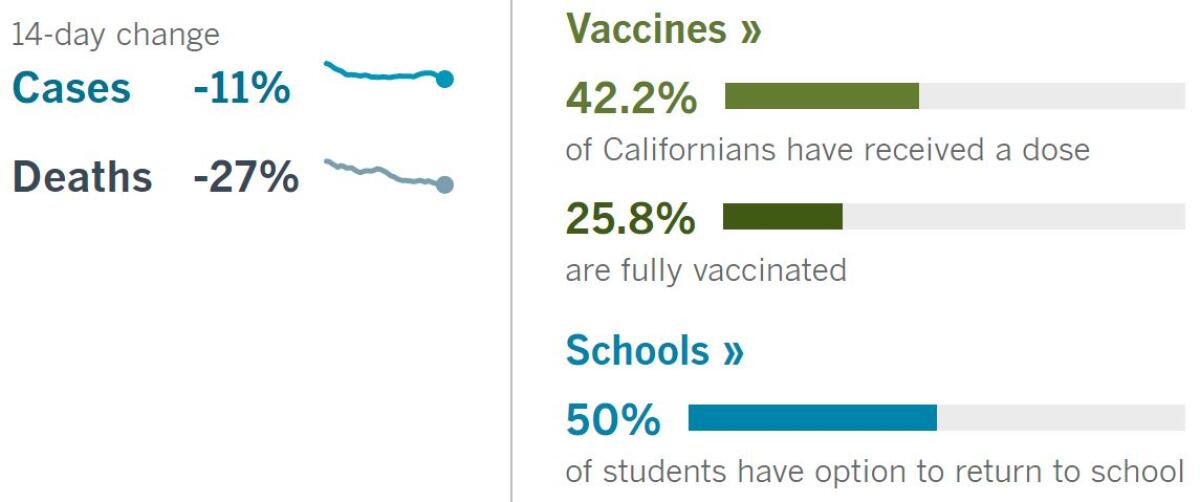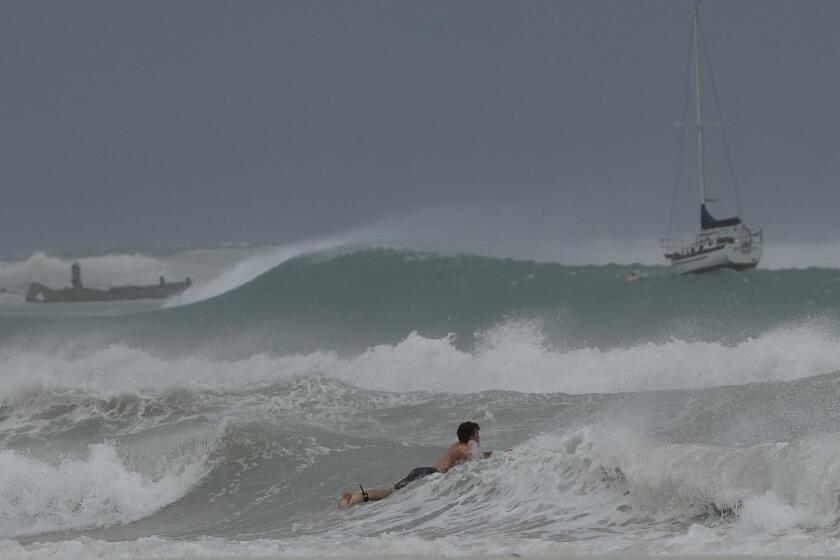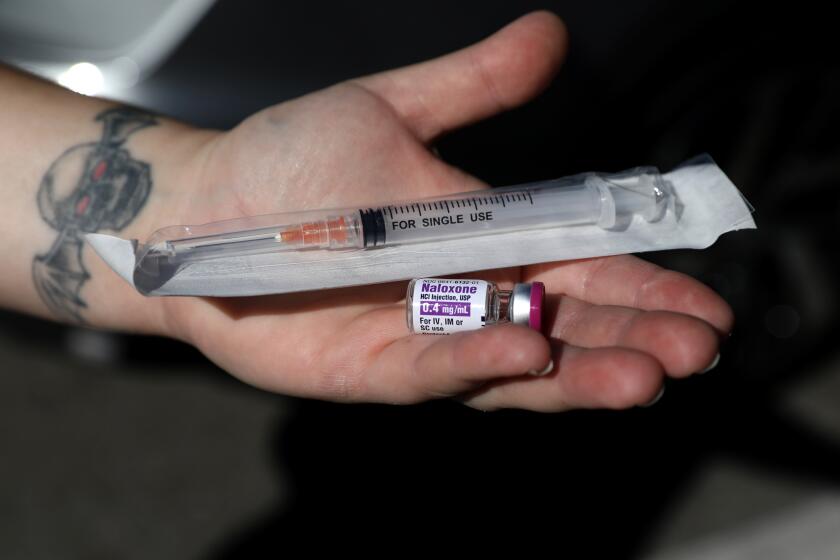Coronavirus Today: Long live rock ‘n’ roll!
Good evening. I’m Melody Petersen, and it’s Tuesday, April 20. Here’s what’s happening with the coronavirus in California and beyond.
In this newsletter, we spend a lot of time talking about school shutdowns, the challenges of distance learning, and the uneven path back to campus. All of those things are vitally important. But today we bring you a different kind of education story — one about rock ‘n’ roll.
Before the pandemic, student attendance at the real-life School of Rock had soared to an all-time high.
Despite a gradual decline in guitar sales and rock’s waning presence on the Billboard charts, the School of Rock and its dynamic, hands-on teaching method had only grown more popular among school-age children. In the last decade, it had expanded into a global network of 260 music programs across nine countries, including seven locations in the Los Angeles area.
Then COVID-19 turned down the volume, writes my colleague Suzy Exposito.
“We were bursting at the seams, having serious conversations about if we had enough rooms and capacity for the next five years,” said Justin Salmons, general manager at the West L.A. School of Rock. “Then the pandemic hit, and [West L.A.] went from a total student count of 230 students and rapidly growing, to 129 today.”
Founded in 1998 by Philadelphia musician and philanthropist Paul Green, the School of Rock is not your standard after-school music class: It’s a year-round program dedicated to teaching music through both classic and contemporary rock songs, which students ages 8 to 18 first learn to perform privately, then together in bands. Ultimately, each band is thrust into the limelight, ready to shred their favorite Beatles, Nirvana or Bikini Kill song before a live audience.
With an education model contingent on live performance, the School of Rock had to modify its methods because of the pandemic — and quickly.

By March 2020, the School of Rock network pivoted entirely to remote instruction. It also offered a new app to record and mix tracks, as well as livestream events with visiting music professionals. A streaming party next month, for instance, will feature superstars Stevie Wonder and members of the Rolling Stones.
Even when classes transpire remotely, the School of Rock is a considerable step up from learning guitar from YouTube, a hobby many adults took up to combat the 2020 quarantine blues.
And yet Zoom fatigue is real, Salmons said. “Kids are stressed out and isolated from each other — even my teenagers want breaks from their screens.”
A recent poll of students in the program and their families revealed that more than two-thirds of respondents wished to return to in-person classes.
“I got frustrated with the computer because sometimes [teachers] couldn’t hear me,” said 9-year-old drum student Chloe Ingram.
And so, beginning May 1, the School of Rock will allow L.A. students to step out of the virtual classroom and into a real one. Chloe will return to the location in Venice.
She first took up the drums to blow off steam when angry — but during the pandemic, she’s had to make do with discreet electric drum pads in her family’s apartment. She hasn’t touched a full drum kit in 13 months, and her mom, Wyleen Ingram, said the lack of an audience is starting to wear on her.
“I like playing in front of everybody,” Chloe said. “I like putting my own spin on songs and showing what I can do.”
By the numbers
California cases, deaths and vaccinations as of 6:21 p.m. Tuesday:

Track California’s coronavirus spread and vaccination efforts — including the latest numbers and how they break down — with our graphics.

Across California
Five more counties have moved into the orange tier of the state’s COVID-19 reopening system, continuing a sustained and sweeping unlocking of the economy as case rates remain low and vaccinations ramp up.
Data released Tuesday by the California Department of Public Health indicate Santa Barbara, Fresno, Kings, Calaveras and Mono counties all advanced from the red tier to orange. That means capacity limits can be increased at restaurants, gyms, museums, movie theaters and a host of other businesses.
With the latest moves, 38 of California’s 58 counties have now reached the orange tier, and three have entered the final — yellow — tier. Seventeen counties remain in the red tier, and none are left in the strictest — purple — tier.
Compare that with March 9, when 34 counties were still in the purple tier and only four had made it to orange or yellow.
The rapid reopenings over the last six weeks have been fueled by two inversely related trends: a drop in the reported number of new coronavirus cases and a steady increase in how many Californians are vaccinated against COVID-19.
Vaccinations were stalled briefly Tuesday at Dodger Stadium and eight other sites operated by the city of Los Angeles in anticipation of possible mass demonstrations after the murder conviction of former Minneapolis Police Officer Derek Chauvin.
The temporary closures, which also applied to mobile vaccination clinics run by the city, were a “simple precaution,” according to Mayor Eric Garcetti.
Patients who had appointments scheduled at city sites Tuesday afternoon should be notified by Carbon Health, the company that manages the sites, the mayor’s office said. Appointments will be rescheduled for later this week.
Some people said on social media Tuesday afternoon that they learned of the closures only when they arrived for their vaccination appointments and were turned away.
Readers in L.A. County will soon get a chance to return to public libraries after more than a year of being locked out because of the pandemic.
Some L.A. County Library branches opened their doors this week for limited in-person services, such as browsing and checking out books, printing and surfing the internet, and asking the reference desk for assistance in finding materials or information.
The Los Angeles Public Library is expected to reopen May 3 with similar limited services at 38 of its 70-plus locations.
Even with the reopenings, both city and county libraries will continue offering sidewalk services for the foreseeable future.
Masks and social distancing will be enforced. Signs will direct foot traffic. Furniture and bookshelves have been reorganized. Disposable keyboard covers will be provided at computer stations. Plexiglass has been installed in places, and hand sanitizer will be readily available.
Under the state’s reopening blueprint, libraries in orange-tier counties — such as Los Angeles — are permitted to reopen fully without limits on the number of patrons inside. Yet counties can impose stricter rules, and L.A. County health officials reduced libraries’ capacity to a maximum of 75%.
County library officials went a step further, opting to limit capacity to 50%. Electronic signs posted at the entrances will show the number of people inside the buildings and will list how many more are allowed to join them. Once capacity is reached, staff will notify those inside to wrap up to let others in.
“It’ll look a little different, but we’re hoping all our safety measures ensure our customers have a great experience and still recall we’re the center for community,” said Skye Patrick, director of the L.A. County Library.


See the latest on California’s coronavirus closures and reopenings, and the metrics that inform them, with our tracker.
Consider subscribing to the Los Angeles Times
Your support helps us deliver the news that matters most. Become a subscriber.
Around the nation and the world
Experts at the agency that regulates drugs in the European Union said Tuesday that they found a “possible link” between the Johnson & Johnson vaccine and very rare blood clots after a small number of cases were reported in the U.S. But they confirmed that the vaccine’s benefits still outweighed the very small risk of developing the unusual clots.
The European Medicines Agency said a warning should be added to labels for the Johnson & Johnson vaccine. The unusual blood clots should be considered “very rare side effects of the vaccine,” it said.
Last week, Johnson & Johnson halted the European rollout of its one-dose vaccine after the Food and Drug Administration recommended a pause in its use in the U.S. Widespread use of the shot in Europe has not yet started.
The delay was a further blow to vaccination efforts in the European Union, which have been beset by supply shortages, logistical problems and concerns over unusual blood clots in a small number of people who received AstraZeneca’s COVID-19 vaccine, which is not yet available in the U.S.
Experts worry the temporary halt of the Johnson & Johnson shots could complicate worldwide immunization efforts. Last week, South Africa suspended its use of the vaccine in the wake of the U.S. pause, and countries including Italy, Romania, the Netherlands, Denmark and Croatia put their doses into storage.
A committee of vaccine experts that advises the U.S. Centers for Disease Control and Prevention is scheduled to discuss the Johnson & Johnson vaccine and possible next steps at a Friday meeting.
With the coronavirus continuing to surge in many parts of the globe, the U.S. State Department is urging Americans to reconsider their international travel plans.
State Department officials said they would soon issue specific warnings not to visit roughly 80% of the world’s countries due to risks from the pandemic.
The U.S. hasn’t had a global advisory warning against international travel since August, when guidance was revoked by the Trump administration.
Travel is also discouraged for the remaining 20% of countries, though not as emphatically.
The State Department did not reveal which countries would fall under which category. That will become known as guidance is issued individually for each country in the coming week.
And if you’re looking to stay closer to home but still have fun at a U.S. theme park, get ready to be tracked by the increasing use of apps aimed at making visits safer.
At theme parks, the biggest risk factor for spreading the virus is also the biggest headache: long waits in packed crowds. Parks hope to reduce them by employing touchless payment systems to order food, apps to schedule times to ride attractions or make dining reservations, and other high-tech solutions.
“In the past several months, our tech teams have accelerated our move to digital in a big way,” Disneyland spokesperson Liz Jaeger told Times staff writer Hugo Martin.
Helpful as they may be, the apps also help the theme parks collect more information about their visitors.
Privacy advocates say the trend gives theme parks greater opportunity to upsell visitors on merchandise, food and drinks. And they worry that the personal and financial information collected from parkgoers can be leaked or shared in unexpected ways.
“While theme parks may be pushing smartphone purchases as a form of convenience or even as a health measure, we should be very aware of the fact that this is also a huge opportunity for them to make a grab at our data, using it for everything from marketing to enforcement of park rules,” said Evan Greer, director of the digital rights group Fight for the Future.
Your questions answered
Today’s question comes from readers who want to know: Can my employer require me to get the COVID-19 vaccine?
Certain employers have long been able to require vaccinations, as long as they can show that such a mandate is “job-related and consistent with business necessity” or justified by a “direct threat” to the workforce, according to the Americans With Disabilities Act.
Workplaces that might fall into that category are those that have direct contact with the general public (such as grocery stores), healthcare settings (hospitals) and ones where jobs are performed in close quarters with others (factories). Office workers who can perform their duties from home? Not so much.
However, the more pressing question may be: Can employers mandate it now?
The answer: Probably, but it may be up to the courts to decide.
The issue is murky because the three vaccines currently authorized in the U.S. didn’t go through the regular FDA approval process. Instead they are being administered under emergency-use authorizations. Language in the emergency-use authorization says vaccination recipients “have the option to accept or refuse the vaccine.”
Some labor-law experts say that means the government can’t force citizens to get vaccinated but that private-sector employers can, given the broad discretion they have to dismiss workers under the “at-will” employment doctrine.
Lawsuits have been filed. For example, a group that includes teachers and other staff at L.A. Unified is suing the district over its requirement that employees be vaccinated, and they point out that the vaccines have not gained full FDA approval.
We want to hear from you. Email us your coronavirus questions, and we’ll do our best to answer them. Wondering if your question’s already been answered? Check out our archive here.
Resources
Need a vaccine? Keep in mind that supplies are limited, and getting one can be a challenge. Sign up for email updates, check your eligibility and, if you’re eligible, make an appointment where you live: City of Los Angeles | Los Angeles County | Kern County | Orange County | Riverside County | San Bernardino County | San Diego County | San Luis Obispo County | Santa Barbara County | Ventura County
Need more vaccine help? Talk to your healthcare provider. Call the state’s COVID-19 hotline at (833) 422-4255. And consult our county-by-county guides to getting vaccinated.
Practice social distancing using these tips, and wear a mask or two.
Watch for symptoms such as fever, cough, shortness of breath, chills, shaking with chills, muscle pain, headache, sore throat and loss of taste or smell. Here’s what to look for and when.
Need to get tested? Here’s where you can in L.A. County and around California.
Americans are hurting in many ways. We have advice for helping kids cope, resources for people experiencing domestic abuse and a newsletter to help you make ends meet.
We’ve answered hundreds of readers’ questions. Explore them in our archive here.
For our most up-to-date coverage, visit our homepage and our Health section, get our breaking news alerts, and follow us on Twitter and Instagram.




